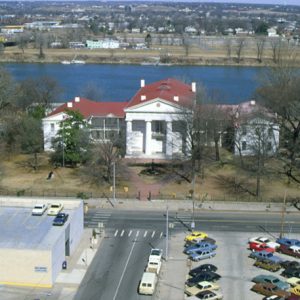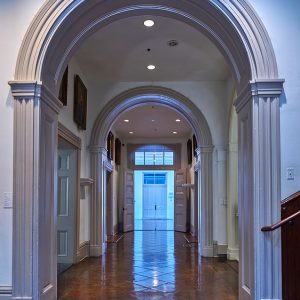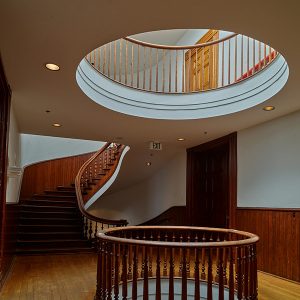calsfoundation@cals.org
Old State House
The Old State House in Little Rock (Pulaski County) is the oldest standing state capitol building west of the Mississippi River. The structure was built to accommodate all branches of the new state’s government. It served a multitude of uses before becoming, in 1951, a museum of Arkansas history. Under the direction of the Department of Arkansas Heritage, the Old State House Museum continues to interpret Arkansas history from statehood to the present.
In 1833, believing that Arkansas would soon achieve statehood, territorial governor John Pope hired Gideon Shryock, the architect of the Kentucky State Capitol, to design a state capitol building perched high on a bank of the Arkansas River. Shryock drew up plans for a large stone structure with a copper roof, built in the Greek Revival architectural style so popular for public buildings at that time. He sent associate George Weigart to oversee the work. Weigart modified the plans due to budget limitations, reduced the size of the building, replaced the stone with stucco-covered brick, and used faux graining on interior doors and columns and faux marbling on mantles. It is originally believed to have been designed as three separate buildings to house the three branches of government. The central block featured a portico with a massive pediment and Doric columns on both the north and south façades. Construction was well under way by 1836, when Arkansas became a state.
The House and Senate chambers (legislative branch) were located in the center section, with the executive branch in the west wing and the judicial branch in the east wing. The first session of the Arkansas General Assembly met in the original House of Representatives chamber in 1836 while construction continued around the legislators. Although Governor Archibald Yell declared the building “complete” in 1842, covered walkways were soon added to connect the three structures.
In 1885, the State House saw its first expansion. The columns and porch on the north (or river) side—twin to the Markham Street side—were removed, and the building was extended approximately fifty feet, creating a larger chamber for an expanded House of Representatives. The Greek Revival–style porch on the river side was not replaced. Some interior improvements included Victorian-influenced curving staircases, skylights, and an opening in the rotunda area, while exterior improvements featured elaborate iron grillwork and statues of the Three Graces (Law, Justice, and Mercy) placed atop the building.
The State House was the site of many significant events throughout the nineteenth century. In 1837, Speaker of the House John Wilson fatally stabbed Representative Joseph J. Anthony after a debate over taxes. In May 1861, the second session of the Secession Convention met in the original House of Representatives chamber; all but one delegate, Isaac Murphy, voted for the state to secede from the Union. The building was home to the Confederate government until Union forces captured Little Rock in September 1863, leading the Confederate government to relocate to Washington (Hempstead County). Isaac Murphy was then sworn in as governor of Federal-controlled Arkansas.
In 1874, the State House was the scene of another armed conflict, the Brooks-Baxter War, as Joseph Brooks and Elisha Baxter fought over the outcome of the 1872 gubernatorial race. In 1891, Arkansas legislators engaged in fiery debate over the proposed Separate Coach Law, which would separate blacks and whites riding in the same train cars; the bill passed virtually unopposed in both the Senate and the House of Representatives and became the first of many segregationist laws passed in Arkansas.
The grounds of the State House are home to several famous landmarks. The three-tiered fountain with cranes is a recast of the original fountain that sat in front of the Arkansas Building during the 1876 Philadelphia Centennial Exposition. The fountain traveled by train to Arkansas after the exposition ended and was installed in front of the State House in 1877, one year before the first city water system began to operate. The Lady Baxter Cannon is a Civil War–era cannon used as part of Little Rock’s defense against Union forces. Later, Elisha Baxter’s supporters moved the cannon to the grounds during the Brooks-Baxter War.
By 1911, the State House was badly in need of repair. State government had outgrown the building, and many legislators objected to spending money to repair a building that was by then too small. Following completion of a new state capitol, all government offices moved out of the State House, leaving its future in question. The next year, the University of Arkansas Medical Department (now the University of Arkansas for Medical Sciences) moved into the former capitol and operated in parts of the building until 1935. An important research endeavor with national and international significance, known as the Crossett Experiment, was conducted by the Arkansas Board of Health and the medical school to eradicate hookworm and malaria.
The building was given to the Arkansas Department of the American Legion and renamed the Arkansas War Memorial in 1921. The building offered services for returning veterans, including a soup kitchen, but was most well known as a monument for all Arkansas veterans. Patriotic and civic organizations—such as the Arkansas Veterans Service Bureau, the Arkansas Pioneers Association, the Daughters of the American Revolution, the United Daughters of the Confederacy, the Sons of Confederate Veterans, and the Boy Scouts and Girl Scouts—shared space with the medical school during the early twentieth century.
Members of these patriotic organizations helped lobby the Arkansas General Assembly to restore the former State House and turn it into a museum. In 1947, legislation was passed that turned the former capitol into a museum of Arkansas history. After undergoing restoration costing $350,000, which included replacing the roof and other significant structural improvements, the former state capitol officially opened to the public on February 14, 1951. On December 3, 1969, the Old State House was listed on the National Register of Historic Places. Early exhibits in the museum included period rooms; the west wing of the building also housed the Arkansas History Commission (now called the Arkansas State Archives) until its move to the current Arkansas State Capitol complex in 1979.
Agnes Loewer, the museum’s first curator, initiated a donation and collection policy shortly after coming to work. Over the years, the museum has aggressively collected materials such as items related to Arkansas’s first families, nineteenth- and twentieth-century politics, and architecture; quilts made by black Arkansans; art pottery; nineteenth-century battle flags; and memorabilia of the Arkansas State Police. The museum sponsors and publishes original research for permanent and changing exhibitions.
The museum continues to host significant events. Governor William Jefferson Clinton announced his run for U.S. president on the front lawn of the State House and held victory night watch parties there in 1992, and again in 1996. On December 9, 1997, the Old State House was designated a National Historic Landmark, the highest recognition a building can receive, due to the significance of the Crossett Experiment.
Today, this state-run museum is open free of charge 361 days each year and interprets Arkansas history from statehood to the present through both permanent and changing exhibits. Permanent exhibits include “Pillars of Power,” devoted to the history of the building itself; “First Families of Arkansas,” featuring political memorabilia and the inaugural gowns worn by Arkansas’s first ladies; the 1836 House of Representatives chamber, restored to its 1840s appearance; and the 1885 House of Representatives chamber. The museum offers hourly on-site tours and provides free on-site programming for visitors of all ages, including gallery talks and lectures, musical concerts, family programs, summer youth camps, hands-on activities for K-12 audiences, and living history. The museum’s outreach program is extensive as well. Education staff members travel throughout Arkansas providing programs free of charge for youth and adult audiences on topics relating to the history of the building, as well as to both permanent and changing exhibits. Program themes include music, politics, architecture, military history, quilting, women’s history, and prehistoric history.
For additional information:
An Enduring Image: Arkansas’s Old State House. Old State House Museum Virtual Exhibit. http://www.oldstatehouse.com/exhibits/archive/enduring-images.aspx (accessed September 12, 2022).
Guendling, Randall L., and Mary L. Kwas. “The Historical Archeology of Arkansas’ Old State House.” Fayetteville: Arkansas Archeological Survey, 1997.
Kwas, Mary L. A Pictorial History of Arkansas’s Old State House: Celebrating 175 Years. Fayetteville: University of Arkansas Press, 2011.
“Old State House.” National Register of Historic Places nomination form. On file at Arkansas Historic Preservation Program, Little Rock, Arkansas. Online at http://www.arkansaspreservation.com/National-Register-Listings/PDF/PU3095.nr.pdf (accessed September 12, 2022).
Old State House Museum. http://www.oldstatehouse.org/ (accessed September 12, 2022).
Pitcock, Cynthia DeHaven. “National Historic Landmarks of Arkansas: The Old State House and the Crossett Experiment.” Little Rock: Arkansas Historic Preservation Program, 1997. Online at http://www.arkansaspreservation.com/News-and-Events/publications (accessed September 12, 2022).
Shank, Ned. Arkansas’ First State Capitol, 1885–1947. Little Rock: Arkansas Commemorative Commission, 1977.
Georganne Sisco
Old State House Museum
 Brownlee, Robert
Brownlee, Robert Gulley, Louis Corneil
Gulley, Louis Corneil Historic Preservation
Historic Preservation Hodges, Earle William
Hodges, Earle William Arkansas General Assembly, 1909
Arkansas General Assembly, 1909  David O. Dodd Monument
David O. Dodd Monument  "Lady Baxter"
"Lady Baxter"  Old State House
Old State House  Old State House
Old State House  Old State House
Old State House  Old State House
Old State House  Old State House
Old State House  Old State House Grounds
Old State House Grounds  Old State House Interior Hall
Old State House Interior Hall  Old State House Museum
Old State House Museum  Old State House Petition
Old State House Petition  Old State House, Union Occupation
Old State House, Union Occupation  Winding Staircase
Winding Staircase 



Comments
No comments on this entry yet.